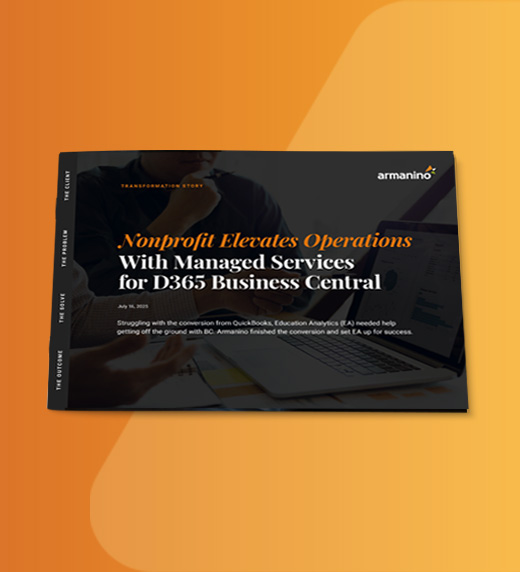As a nonprofit leader, you’re constantly balancing new opportunities with existing and emerging challenges. Donor behavior is shifting, technology keeps evolving and a new presidential administration is rolling out policy changes that could shake up funding — putting you under tremendous pressure to adapt without losing sight of your core mission.
To stay ahead, you need to know what’s coming. So here’s a look at some top trends to anticipate in 2025 and beyond. Understanding them and taking proactive steps to prepare will help you fortify your mission, secure funding and stay resilient in the year ahead.
Trend #1: Tax Law Changes Could Disrupt Charitable Giving
Several potential national tax policy shifts could affect donor contributions this year:
- Charitable contribution limits: The 2017 Tax Cuts and Jobs Act (TCJA) temporarily raised the limit for cash donations to public charities from 50% to 60% of adjusted gross income (AGI). This provision is set to expire on December 31, 2025, reverting the limit back to 50% of AGI. However, the Republican-led Congress may push to extend these higher deduction limits.
- Estate and gift tax exemptions: Under the TCJA, the current lifetime estate and gift tax exemption is at a historically high $13.99 million per individual for 2025. This exemption is set to shrink to approximately $7 million starting January 1, 2026. It’s likely that Republican lawmakers will try to extend these higher exemptions, which could influence high-net-worth individuals’ charitable planning strategies.
- Universal charitable deduction: Proposed legislation, such as the Charitable Act, aims to introduce a universal charitable deduction. This would allow non-itemizing taxpayers to deduct up to one-third of the standard deduction for charitable contributions, potentially broadening the donor base and boosting overall charitable giving.
The future of these extensions and proposals and their impact remains uncertain. Changes to deduction limits or estate taxes might reduce individual donations, which could prompt your organization to rethink funding strategies and explore other ways to offset donation decreases.
How you can prepare:
- Stay informed. Regularly monitor national, regional and local legislative developments to understand how new tax policies may impact donor incentives.
- Develop contingency plans. Anticipate how tax policy shifts might impact funding and create scenario-based backup plans to sustain your programs.
- Educate donors on tax-efficient giving. Provide donors with information on tax planning gifting strategies such as stock donations, donor-advised funds (DAFs) and planned giving to help maximize their tax benefits.
- Explore alternative funding sources. Increase corporate partnerships, pursue grant funding and look for other ways to offset potential declines in individual giving.
Trend #2: Nonprofits Are Diversifying Revenue Streams for Stability
If your organization depends on a single revenue stream, it could leave you vulnerable to financial instability. Rising operational costs, economic uncertainty and potential policy shifts are prompting nonprofits to build more resilient financial models, with many exploring revenue diversification to shore up their resources. Having a diverse revenue portfolio can help you stay flexible amid economic downturns and changes in donor behavior.
How you can prepare:
- Expand your revenue mix. Build diverse funding pathways that sustain and expand your mission’s reach. Strike a balance between stable, dependable funding like grants and partnerships and potential growth opportunities like major gifts or online fundraising campaigns. Reviewing your cash position and assessing your current funding sources can help identify gaps and areas of overreliance.
- Create recurring revenue streams. Build predictable income through monthly giving programs, multi-year pledges, membership models, subscription-based services or community giving circles. Digital fundraising platforms like GoFundMe Pro (formerly Classy) can help reinforce donor loyalty with consistent impact reporting and value-driven engagement.
- Find new donor segments. Use your CRM and website analytics to spot trends and nurture relationships with untapped donor groups like younger or digital-first donors. Optimize your online presence for search and mobile, experiment with different social media platforms and consider AI tools to help target and personalize outreach without losing the human touch.
Trend #3: AI and Machine Learning Are Driving Smarter Donor Engagement
Artificial intelligence (AI) and machine learning have become integral to nonprofit operations. According to Nonprofit Pro’s 40 Nonprofit Trends for 2025 Report, more than half of nonprofits are now using AI-enabled tools, and that number is only expected to rise.
As AI tools become more accessible, now is the time to adapt and embrace them. AI can help you simplify administrative processes, strengthen donor relationships and improve retention by predicting giving patterns and automating outreach. If you don’t adapt? You may miss valuable opportunities to attract donors and operate more efficiently.
How you can prepare:
- Assess where AI could be a good fit. Find redundant, error-prone processes where AI could improve efficiency. For example, automating repetitive tasks like data entry, donor segmentation or gift processing can save time, cut costs and free up your team to focus on advancing your core mission.
- Lay the groundwork for successful AI integration. A strong data foundation makes AI more effective. Audit your current data management practices, clean up donor records and ensure your CRM and tech stack are AI-ready by standardizing data, simplifying workflows and enabling integrations.
- Support AI readiness across your team. Develop internal processes around AI use, provide training on tools like ChatGPT or Copilot and encourage experimentation with low-risk use cases.
- Turn data into impact. Great decisions start with powerful data. Implement AI-powered tools like Microsoft Dynamics 365 CRM and Salesforce that enhance financial visibility, centralize donor information, uncover giving trends and generate real-time insights that deliver measurable outcomes.
Trend #4: Cloud Technology Continues to Transform Nonprofit Operations
Embracing cloud ERP solutions and other technology has become standard procedure for nonprofits looking to simplify operations, stretch resources and stay competitive. Cloud software equips your nonprofit to scale with ease, adapt quickly to changes and access real-time data, all while doing more with less.
How you can prepare:
- Clean and secure your data. Before migrating to the cloud, assess your data for accuracy and remove duplicative information. Strengthen security with encryption, multi-factor authentication and donor privacy law compliance.
- Evaluate integration needs. Determine which existing systems need to connect with your new cloud tools and address any data barriers before implementation.
- Invest in technology that grows with you. Choose cloud solutions that integrate easily with your existing tools. Build your tech stack with future growth in mind.
Trend #5: Digital Giving Is Surging
Online donations are on the rise, surpassing traditional fundraising methods. According to NextAfter’s 2024 Digital Fundraising Benchmark Report, online donation revenue from a broad range of small and mid-sized donors grew by 99% over the past 5 years, while broad-base offline donations grew by 36%. As digital giving continues to increase, nonprofits must embrace innovative strategies to engage online donors and drive contributions.
How you can prepare:
- Strengthen your digital strategy. Use A/B testing (comparing different versions of emails, ads or web pages to see what performs best) and AI-fueled insights to refine messaging, boost conversion rates and make the online donation process quick and easy.
- Launch peer-to-peer giving campaigns. Encourage supporters to fundraise on your behalf for events, milestones or special days like Giving Tuesday to create a broader donor network.
- Create engaging, high-impact content. Make your story stand out. Share short videos and eye-catching visuals on social media to attract attention, connect with supporters and inspire action across social channels.
- Rethink your fundraising approach. If you’re struggling with audience engagement or stagnating contributions, consider outsourcing your fundraising. Nonprofit strategic development outsourcing can inject fresh expertise and tech-driven solutions into your strategy for more intentional and profitable fundraising.
Trend #6: Data-Driven Impact Reporting Is Becoming Nonnegotiable
You know you’re making a difference. But proving it to donors and grantors? That’s a whole other challenge. With growing competition for donor dollars, telling a captivating story — and having the data to back it up — is essential to stand out.
How you can prepare:
- Show your mission in motion: Build compelling cases for support by measuring and highlighting your nonprofit’s concrete outcomes. Consider creative ways to underscore your outcomes-focused reporting and reinforce your programmatic impact.
- Harness advanced analytics. Show stakeholders the true scope and power of your work. Provide real-time impact reporting with AI-backed dashboards that demonstrate clear results to funders.
- Prove your nonprofit’s efficiency. Donors want to know their money is being well-spent. Highlight your operational transparency and demonstrate how every dollar contributes to meaningful outcomes.
- Tell your community success story. Use before-and-after comparisons to communicate your organization’s positive influence and inspire greater support.
Trend #7: Cross-Sector Partnerships Are Creating Growth Opportunities
Partnerships between nonprofits, businesses and government agencies are becoming more common, creating new opportunities for resource sharing and cross-sector innovation. Research from The Sustained Collaboration Network found that 73% of nonprofits that collaborated — whether through mergers, shared programs or joint initiatives — achieved measurable success, including expanded services, increased funding and improved program outcomes. This trend is introducing new opportunities for growth, so now is the time to lean into collaboration.
How you can prepare:
- Identify high-impact partners. Work with companies and nonprofits that share your mission. Move beyond one-off sponsorships and focus on building lasting, strategic partnerships.
- Assess internal gaps in operations or finance. Identify areas where shared services — centralized support functions that are used across multiple organizations — like accounting, HR, IT or grant management could improve efficiency and free up resources for mission-critical work.
- Mobilize board members, staff and stakeholders as community ambassadors. More than likely, the people involved with your nonprofit truly care about your mission. Give them the tools to be boots-on-the-ground advocates for your cause, so they can spearhead cross-sector partnerships or host collaborative events. Offer meaningful engagement opportunities. Create corporate volunteer programs, co-branded initiatives or long-term funding partnerships that align with your nonprofit’s goals.
Trend #8: DAFs and Venture Philanthropy Are on the Rise
DAFs — charitable giving accounts managed by financial institutions — have become a popular option for donors. With over $250 billion sitting in DAFs waiting to be distributed, nonprofits that actively build relationships with DAF holders will see greater funding opportunities, though accessing these funds may take time. Venture philanthropy is also gaining traction, with high-net-worth donors taking an active role in impact investing, hoping for long-term, sustainable results.
How you can prepare:
- Build relationships with DAF holders. Many DAF holders are looking for meaningful cases but need guidance. Work with wealth advisors, community foundations and financial institutions to connect with donors who align with your mission. Offer clear, compelling reasons why your nonprofit is an ideal recipient for their funds.
- Demonstrate measurable impact for venture philanthropists. Unlike traditional donors, venture philanthropists want to see a return on their social investment. Use data-driven storytelling like case studies to demonstrate long-term impact.
- Engage major donors with strategic giving opportunities. Offer personalized ways to support high-impact initiatives, such as naming opportunities (e.g., endowing a scholarship or funding a specific program), matching gift campaigns or multi-year giving commitments that align with the donor’s philanthropic goals.
Secure Your Nonprofit’s Future
Feeling overwhelmed by changing donor expectations, technology needs and shifting federal policy changes? Get practical strategies and solutions from proven experts. Find out how our nonprofit consultants can help you build an unshakable future for your mission, no matter what challenges lie ahead.



